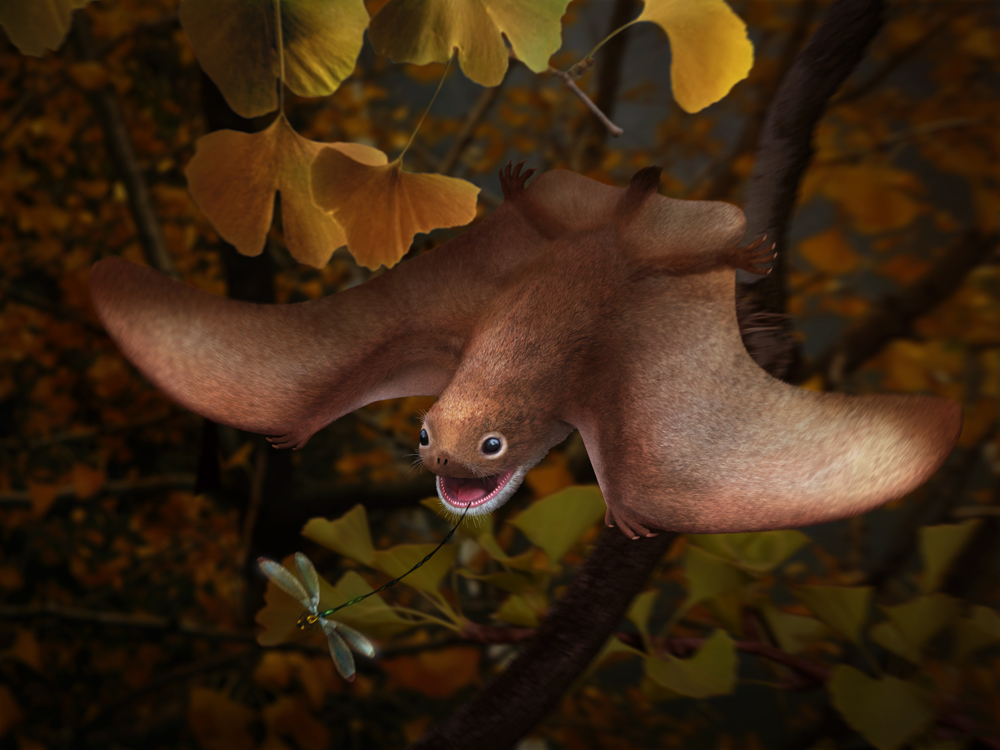Broadtooth Glider
The Gliders sat, hooked into the thick algae carpet that blanketed the underside of the island with tiny claws. Several Gliders crawled quickley, a few lazily scooped lichen into their mouth with shovel-like teeth. One particular specimen stared at me with utter confusion, seemingly wondering why I was dangling from a rope and not hooked onto the Lichen like his kin.Scuttering along the bottom of islands like a mouse, the Broadtooth Glider eats twice its weight in lichen every day. Small and fuzzy animals, these pterosaurs have developed over time to take advantage of the strange terrain of The Shatterlands and glide long distances on the high-speed wind that flows between the massive peaks and valleys of the Aedelo Mountains.
Basic Information
Anatomy
Broadtooth Gliders are small, quadropedal pterosaurs covered head to toe in hair-like pycnofibers. Their fuzzy exterior is a soft cover that allows them to survive in the chilly wind of the Aedelo Mountains, and also allows young members of their species to cling to the backs of their parents.
Broadtooth Gliders also have longer hooked claws on their fore-limbs that turn them into phenomenal climbers. This, combined with powerful forelimb muscles, turn these pterosaurs into both quick fliers and quicker climbers.
Genetics and Reproduction
Like all pterosaurs, Broadtooth Gliders lay eggs. These gliders specifically lay eggs in larger clutches, using the cave opening in the bottom of the Aedelo Mountain Islands as natural protection from predators.
Broadtooth Gliders tend to gestate very quickly, between 10 days and 2 weeks.
Growth Rate & Stages
The young of this species tend to fledge very quickly, within 6-8 weeks. Between their hatching and fledging, young Broadtooth Gliders cling to the backs of their parents. During this time, they are often fed algae by other adults in their group through a process similar to a baby bird being fed by its mother.
After one of these pterosaurs fledge, a mother will try and ween her children and force them into learning flight. This is often done through the mother randomly dropping from the bottom of the island in the middle of the children being fed, forcing them to fly back up to receive their food. If a child is particularly stubborn, some Broadtooth Glider mothers have been known to purposefully shake their children off their backs, allowing them to fall in an attempt to teach them flight before catching them.
Ecology and Habitats
As said previously, the primary habitat of this species is the Algae/Lichen fields that coat the bottom of floating islands in the Aedelo Mountains region. They will often also use the various cave openings that exist in these fields, eating Lichen from the cave walls.
It is easy to find where a group of Broadtooth Gliders have been, as they will often pick entire swaths of area clean of algae save for a few small patches they use to cling.
Dietary Needs and Habits
Broadtooth Gliders use wide, shovel-like teeth to scrape the rocky surfaces of lichen and other nutritious plantlife. Although they mostly consume this lichen on the spot, they will carry lichen in their mouths to a nest site if they are currently nesting eggs.
Additional Information
Perception and Sensory Capabilities
Broadtooth Gliders are renowned for their powerful sense of sight, a byproduct of developed eyes that allow them to send visual signals to each other. This powerful sight allows them to interpret a broad range of colors. This useful adaptation works wonders for these mouse-like fliers, as it helps them make minute distinctions between the various species of lichen that populate their natural environment.

Anurognathus Ammoni by Julio Lacerda
Scientific Name
Agnurathi Molaris
Geographic Distribution
Discovered by



Comments